This post may contain affiliate links. Please read our disclosure policy.
This soft and tender gluten free pita bread is also yeast free, so there’s no rising time. Store-bought gluten free flatbreads simply can’t compare.

Table of Contents
- The best gluten free pita bread recipe
- Gluten free pita bread ingredient notes
- The tools you'll need for this gluten free pita recipe
- Pitas with a pocket but don't pop
- Tips for making the best homemade gluten free pita bread
- Making gluten free pita pockets in advance
- How to serve gluten free pita bread
- Gluten free pita bread: ingredients and substitution suggestions
- FAQs
- How to make gluten free pita bread, step by step
- Easy Gluten Free Pita Bread | Ready in Under 30 Minutes w/ No Yeast Recipe
The best gluten free pita bread recipe
Adding this gluten free pita bread to nearly any meal will turn your ingredients turn into a hearty and satisfying meal. This recipe is one of the most valuable ones I've ever created for that reason alone!
Here are some of the other attributes of this special gf bead recipe:
- It's super fast to prepare. No yeast means no rising time!
- It's cheaper than buying store-bought gf flatbread, which always seems to taste like mashed potatoes (no one knows why).
- These pitas have no dubious additives and preservatives, and no freezer burn from something that's been sitting in your grocer's freezer until someone was willing to overpay for it.
- The pita pockets are fluffy, tender, and buttery (all without any butter added).
Why make your own gluten free pita bread?
Without a really good recipe for gluten free pita bread, if you're gluten free, you'll never again know the beauty of, falafel stuffed into a pita. Or homemade pita chips.
I believe that there is even a value to knowing that you can make your own pita bread even if you do it once and never again. Or even if you never actually make this bread.
Sometimes, just knowing that you can make something gluten free can create a feeling of encouragement and hopefulness. It can help you resist “cheating” on a gluten free diet, too.
Yeast free bread
This recipe for gluten free pita bread is even a bit more special, since it's yeast free. If you're hesitant to try baking yeast bread, or you simply have to eat that way, this recipe is going to be quite a relief.
If you feel like making bread but you find that you're suddenly all out of yeast, or you find that the store shelves are empty, you can make plenty of gluten free bread without yeast.
Gluten free pita bread ingredient notes
- Gluten free flour blend – I highly recommend making this recipe using Better Batter gluten free flour's classic blend, or my mock Better Batter blend. This is a relatively simple recipe, and Better Batter simply has the best formula for making gluten free bread.
- Expandex modified tapioca starch – This is the chemically modified, not genetically modified, form of tapioca starch that plays a central role in our gluten free bread flour blend. Adding a touch of it to this recipe helps strengthen the dough, making it easier to shape raw (as it requires less liquid), and making a more stable gf pita. If you don't have Expandex or don't want to use it, you can replace it with more Better Batter, and increase the liquid by ⅓ as directed in the Recipe Notes below.
- Baking powder – Since we aren't using any yeast in this bread, baking powder provides nearly all the rise. Make sure yours is fresh or your bread will be rock hard!
- Salt – Salt adds brightness and complexity to the pita. Bread without salt has no taste at all!
- Oil – A single tablespoon of a neutral oil (like grapeseed, canola, or vegetable oil) adds some richness and tenderness to the bread without adding any competing flavor.
- Eggs – One egg and one egg white help add structure, a bit of richness, and help your pita bread rise.
- Milk – Milk adds liquid, and some richness, and helps tenderize the dough. Make sure you use milk with some fat, as skim milk will add essentially nothing more than water would.
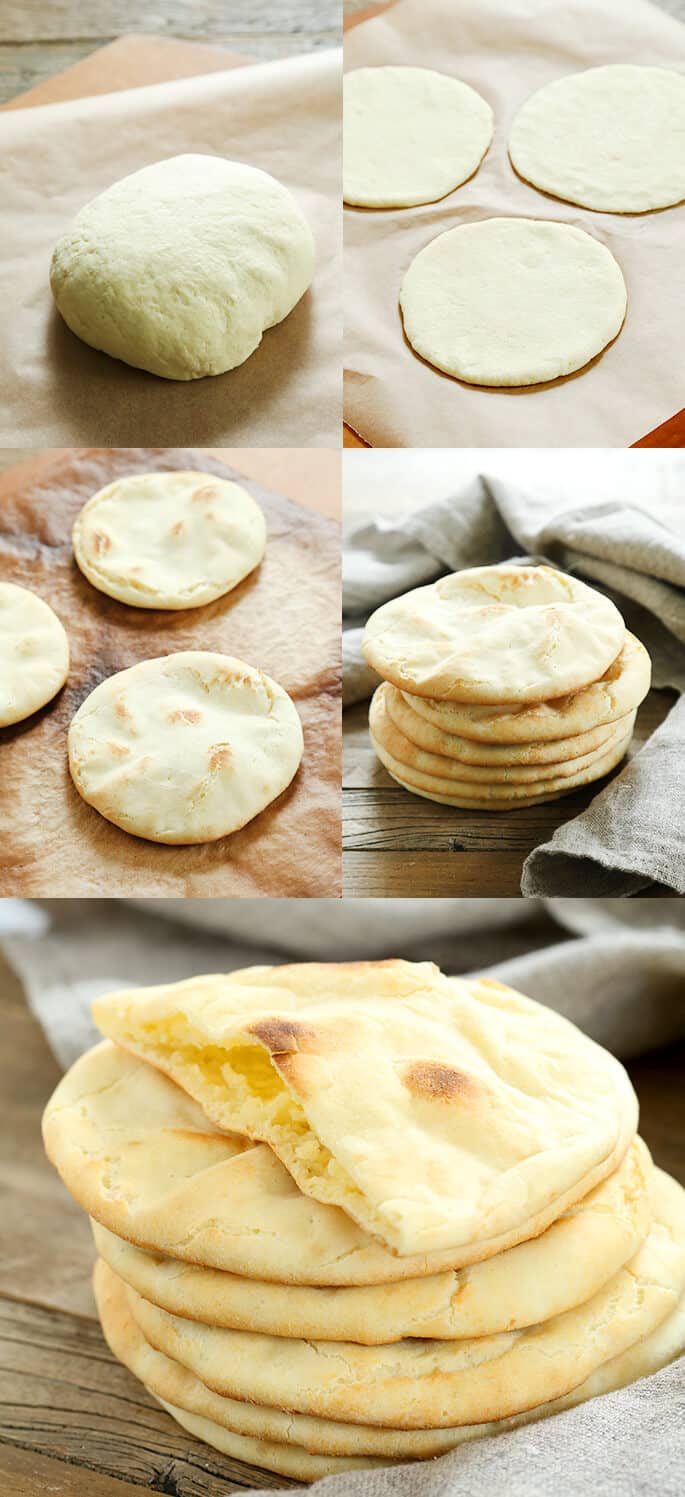
The tools you'll need for this gluten free pita recipe
To make a smooth dough, you'll need either a stand mixer fitted with a paddle attachment, or a food processor fitted with the steel blade. This isn't a dough that you can make with a dough hook, or with the regular beaters on a handheld mixer as they'll simply shred the dough without combining it properly.
If you have a pizza stone, it's really useful to use one in your oven. It will retain enough heat to brown and blister your pitas a bit in the few minutes they're in the oven without having to bake them so long that they end up stiff and tough. If not, at least use an overturned baking sheet to allow the oven's heat to circulate on all sides as much as possible.
Pitas with a pocket but don't pop
Since it's not made the traditional way, and we aren't using my recipe for gluten free bread flour from my Gluten Free Bread Book (there's a recipe for traditional pita bread in there), these pitas don't “pop” to create a perfect pocket.
They do, however, puff up quite a bit, enough that we can coax open a gluten free pita pocket with a sharp knife. They're soft and tender, and almost buttery tasting—even without any butter.
Expect them to crack a bit along the edges as they puff, since only our gluten free bread flour will give you an even enough rise and a strong enough shell to prevent that cracking. It doesn't hurt them one bit, though.
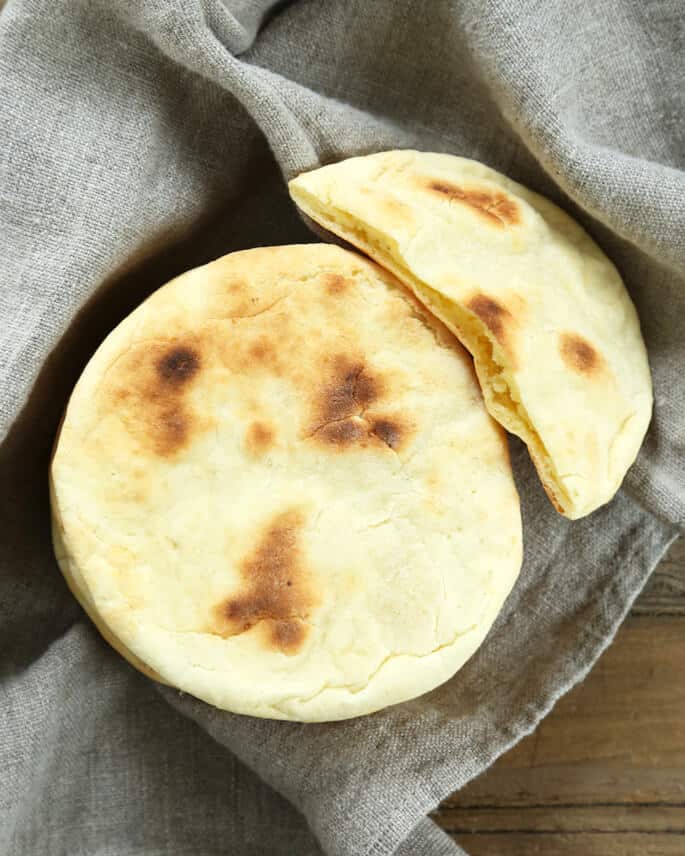
Tips for making the best homemade gluten free pita bread
Roll thinly and evenly for puffy gf pita bread
If you roll the dough thicker than ¼-inch, they'll be too thick and are much less likely to puff up at all. You'll have to bake them too long to get any browning at all, and they'll be a bit stiff. If they're not rolled rather evenly, they are likely to burn in very thin spots and make a pocket impossible.
Don't sweat the details too much
Your pita bread won't be perfectly round, but you only need it to be of even thickness so it bakes evenly. Roundness is not essential. Ovals work just as well!
Keep an eye out for the puffing
Be sure to flip your pitas relatively quickly, so both sides make proper contact with the hot baking surface, and then watch them carefully to remove them when they've puffed as much as they are going to. Overbaking your pitas will cook them too much in the center, which will make them less tender.
Making gluten free pita pockets in advance
Place the warm pitas in a tortilla warmer or seal them, along with a moistened paper towel, in a zip-top bag on the counter for a few hours and they'll stay that way.
For longer storage, cool them completely, wrap tightly and freeze. Defrost at room temperature and refresh in a hot, cast iron skillet or in the microwave wrapped in a moistened paper towel.
But they're so quick and easy, just make them fresh each time. I promise it doesn't take more than 20 minutes, start to finish!
How to store leftover gf pita bread
I don't like to refrigerate bread, even yeast free bread, since the refrigerator tends to dry out baked goods. You can store leftovers in a tightly sealed container (plastic works well here, to retain moisture) for up to 2 days, as long as you've created that pocket soon after baking.
For longer storage, cool them completely, wrap tightly, and freeze. Defrost at room temperature and refresh in a hot, cast iron skillet or in the microwave wrapped in a moistened paper towel.
But they’re so quick and easy, just make them fresh each time. I promise it doesn’t take more than 20 minutes, start to finish!
How to serve gluten free pita bread
- Try stuffing your pita pockets gluten free falafel or chicken salad.
- If you have any pitas that are no longer fresh and weren't stored properly, they're a great candidate for making gluten free pita chips! Just slice into triangles, toss very lightly with some extra virgin olive oil and kosher salt, and bake in a very hot oven, about 425°F until lightly golden all over (about 7 minutes, depending on the thickness of your pita pieces).
- Do you have any pitas that simply wouldn't allow you to create a pocket? Try using them as gf flatbread, add toppings, and place in the toaster oven until melted for a flatbread pizza!
- Try them as a yeast free alternative to gf hamburger buns.
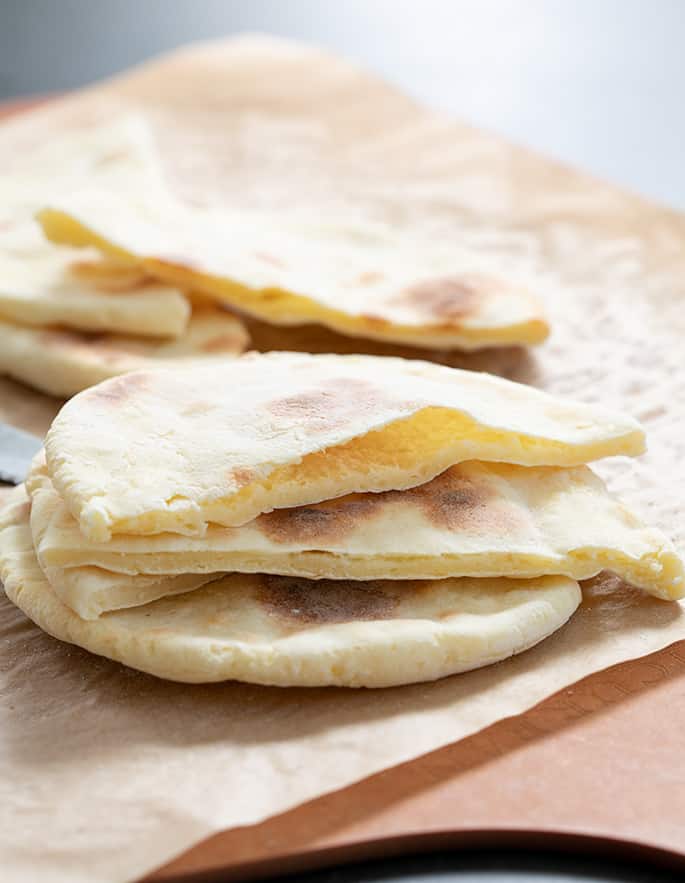
Gluten free pita bread: ingredients and substitution suggestions
Gluten free, dairy free pita bread
The only dairy in this recipe is in cow’s milk. It can easily be replaced with an unsweetened nondairy milk. My favorite is almond milk, since it still has richness. Avoid anything without fat.
Gluten free, egg free pita bread
There is one egg and one egg white in this recipe. The egg yolk adds richness, and the egg whites help balance the moisture and help the bread rise.
You may be able to replace the whole egg in this recipe with a “chia egg” (1 tablespoon ground white chia seeds + 1 tablespoon lukewarm water, mixed and allowed to gel).
For the egg white, try aquafaba (the liquid from a can of chickpeas).
Gluten free, vegan pita bread
To make this recipe vegan, you only need to replace the dairy and the eggs as described above with the dairy free and egg free alternatives recommended.
Expandex modified tapioca starch
Expandex modified tapioca starch is a chemically-modified form of tapioca starch (not genetically modified!) It is not interchangeable with regular tapioca starch/flour.
It’s an amazing addition to this recipe as it provides stability and pliability. If you don’t have Expandex or just don’t want to use it, you can replace it with more all purpose gluten free flour and increase the liquid amount to 1 cup.
Note that if you go this route, the dough will be much wetter and less formed. Handle this dough with wet hands, divide it into 8 portions, and roll each into an approximate ball with wet hands.
Place the dough on a piece of parchment paper, and spread it into a round about 1/4-inch thick by pressing wet fingers down in a circular motion on the dough, and then continue with the recipe instructions as written.
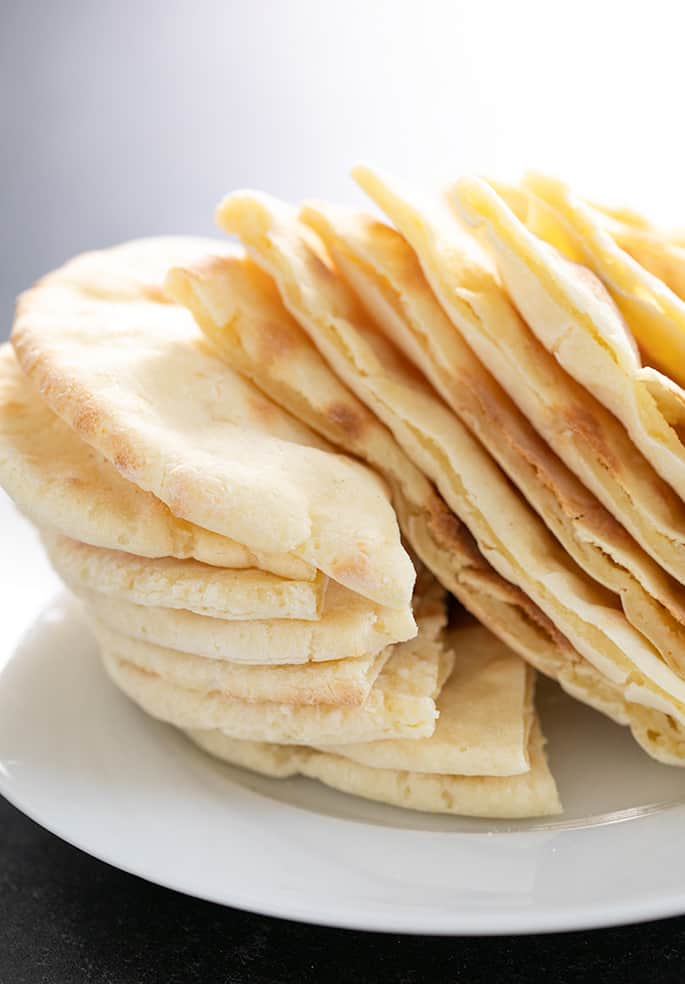
FAQs
Pita is a simple, leavened flatbread common in the Mediterranean and the Middle East. It often has a center pocket where the dough has separated from itself in the center as it rises.
Pita bread is generally made with conventional wheat flour, so it is only gluten free when you use gluten free ingredients and a gf pita recipe, like this one.
Gluten free breads and other baked goods aren't necessarily healthier than their conventional counterparts, unless eating gluten or wheat is bad for your individual health.
No, pita bread is different from naan. Naan bread is more tender and richer, made with yogurt, and generally isn't made to separate from itself to create a pocket, like this type of pita.
No, gyro bread typically doesn't have a pocket, and is more like naan bread. But you can absolutely use pita bread with or without a pocket to serve chicken gyros!
No, I don't recommend making this bread in a skillet. I've tried making this recipe on the stovetop instead of in the oven, and it just doesn't work well. Even when the skillet is covered, the air in the pan just doesn't get hot enough.
The gluten free flour blend that I highly recommend using to make pita bread is Better Batter's classic blend, which is a blend of brown rice flour, white rice flour, potato starch, potato flour, tapioca flour, xanthan gum, and pure powdered pectin.
Pitas that don't swell at all may have been too dry (did you overmeasure your flour? use a different blend?), your oven may not have been hot enough (do you use a standalone analog oven thermometer to check the temperature?), or you may not have rolled them thin enough or evenly enough. Be sure not to work too much extra flour into them as you shape them, either!
How to make gluten free pita bread, step by step
Easy Gluten Free Pita Bread | Ready in Under 30 Minutes w/ No Yeast
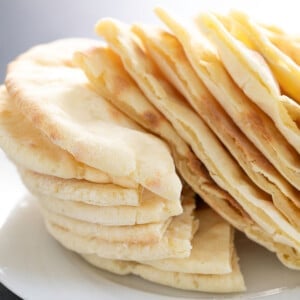
Equipment
- Stand mixer (or food processor)
Ingredients
- 1 ¾ cups (245 g) all purpose gluten free flour blend, (I used Better Batter; click thru for info on appropriate blends), plus more for sprinkling
- 1 teaspoon xanthan gum, omit if your blend already contains it
- ¼ cup (35 g) Expandex modified tapioca starch, (See Recipe Notes)
- 1 ½ teaspoons baking powder
- 1 teaspoon kosher salt
- 1 tablespoon (14 g) neutral oil, (like vegetable, canola or grapeseed)
- 1 (50 g (weighed out of shell)) egg, at room temperature
- 1 (25 g) egg white, at room temperature
- ¾ cup (6 fluid ounces) milk, at room temperature
Instructions
- Preheat your oven to 400°F. If you have a pizza stone, place it in the oven while the oven preheats. If not, use an overturned rimmed baking sheet
- In the bowl of your stand mixer fitted with the paddle attachment (or the bowl of your food processor fitted with the steel blade), place the flour, xanthan gum, Expandex, baking powder and salt. Mix (or pulse) to combine.
- To the dry ingredients, add the oil and then the eggs and milk and beat (or process) the dough until it is very well-combined and parts begin to pull away from the sides of the bowl (about 2 minutes). The dough should be thick and tacky to the touch.
- Turn the dough out onto a very lightly floured surface, and sprinkle it very lightly with more flour. Using a bench scraper or sharp knife, divide the dough into 8 equal parts.
- Roll each into a ball by rotating it in a circular motion on a very lightly floured flat surface. Pat each ball into a disk and then, using a rolling pin and flouring the round very lightly to prevent sticking, roll it out into a round a bit less than 1/4-inch thick.
- Place the disks about 1-inch apart on a piece of unbleached parchment paper. Place the disks on the parchment in the oven (on top of the baking stone or overturned baking sheet) and allow to bake for 2 minutes.
- Working quickly, open the oven and invert the pitas. Allow them to bake for 1 minute and then re-invert and bake until puffed and very pale golden on top (another minute).
- Remove the pitas from the oven, and allow to cool for about 3 minutes, or until they can be handled. Slice each round in half through the center. With a very sharp knife, gently coax open the center of each pita half. Serve warm or at room temperature.
Video
Notes
Nutrition
Nutrition information is automatically calculated, so should only be used as an approximation.



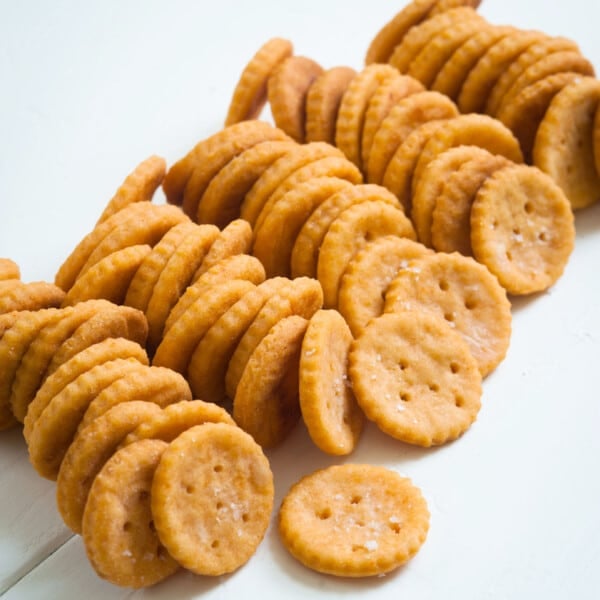


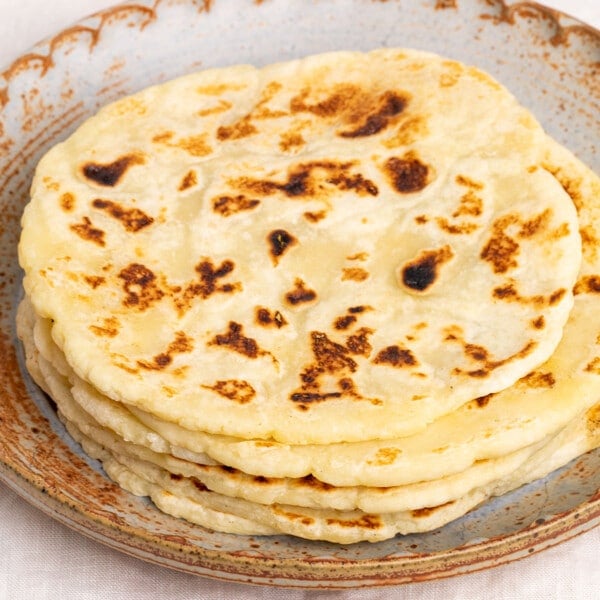









i guess there is no substitution for the dairy then? seeing as many people have asked and there is no response…lol
Unless the recipe indicates otherwise, I haven’t tested my recipes with substitutions, so you will simply have to experiment. That being said, nondairy milk is usually fine, as long as it’s not nonfat. Unsweetened almond milk tends to be a good dairy milk substitute. I discuss substitutions in my FAQs.
Hi Nicole,
My children are egg/dairy/soy free as well as celiac. Could you recommend a vegan egg replacer that is also soy free? Or would this recipe not work well with a replacer? I usually use chia seeds, but they’re more of a binding agent rather than a rising agent.
Much thanks :)
I’m afraid I don’t know what to suggest, Jaime! I’m not overly optimistic, but a chia egg is perhaps worth a shot!
These look delicious! Is there an equilvalant replacement for the milk? We have to be dairy free in my house. Thanks!
i was wondering the same thing as I cant have milk products either….. would love a response nicole! :)
Unless the recipe indicates otherwise, I haven’t tested my recipes with substitutions, so you will simply have to experiment. That being said, nondairy milk is usually fine, as long as it’s not nonfat. Unsweetened almond milk tends to be a good dairy milk substitute. Good luck!
I am gluten free, dairy free and yeast free. Full fat coconut milk works in substitute of dairy milk. Works amazing.
Xanthan gun makesxme sick. Any suggestions ?
H
I live in the UK and can’t seem to find the Expandex Modified Tapioca Starch even checked on Amazon which they don’t have. Can I use Tapioca starch? Or is it something different to Expandex?
You could try Isabel’s GF Baking Fix, which is modified cassava (tapioca) starch. I’ve used it in a few things and found it to be very good. You can buy it online from Isabel’s or from amazon.co.uk.
Thanks for adding that, RedDevil. Isabel’s Baking Fix is, indeed, Expandex as it is available in the U.K.!
By any chance do have the calories per pita? Thank you! They were delicious.
Hi Nicole, I am a new reader and I have been pouring over all your recipes; so excited to start cooking! I just found out that I can’t eat tapioca starch or corn! Now what?! Do you have a flour recipe that does not use Tapioca, or is there a good substitute? Thanks!!
I’ve tried to make pita – it didn’t pop… no idea what I did wrong.. but it was a long time ago and I wasn’t as confident – time to try again!
I am SO Making these this weekend!
I can’t have dairy can I use almond or coconut milk?